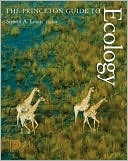The Princeton Guide to Ecology
Search in google:
"A long-needed sourcebook to the science so pertinent to the future, providing rich and eminently readable entries on all aspects of ecology—so valuable that it is hard to imagine how anyone managed without it."—Thomas E. Lovejoy, President, Heinz Center for Science, Economics and the Environment"This is a synoptic survey of our still-advancing understanding of ecological science. It first deals with fundamental principles, ranging from individual plants or animals through populations and ecosystems to entire landscapes. These principles are then applied in insightful discussions of conservation biology, ecosystem services, and ultimately the sustainable management of our planet's biosphere. The 'autecology' of this book is itself remarkable, as tight editing has drawn together contributions from more than one hundred individual authors into a unified whole. In short, the book is a timely and important one."—Robert M. May, University of Oxford"Essential reading for biologists, social scientists, and all interested in a holistic view of the world, this marvelous collection presents the flourishing state of ecology today and its even more exciting prospects for the future."—Peter H. Raven, President, Missouri Botanical Garden"The Princeton Guide to Ecology is an exciting development because it brings together in one place accessible articles written by the leading experts across the important field of ecology. Ecology has grown and repeatedly subdivided in recent years, but now we have it back together again with this enormously useful framework and compendium."—James Gustave Speth, Dean, Yale School of Forestry & Environmental Studies Choice The Princeton Guide to Ecology is a comprehensive assemblage of contemporary ecological research studies and issues related to the different disciplines of the ecological sciences. . . . Technical information throughout the book is presented in a simple-to-understand manner; a comprehensive glossary facilitates further understanding of terminology/concepts. This volume will be useful to students as well as professionals in areas related to environmental health and public policy.
Preface vii Contributors ixPart I: Autecology 1 I.1 Ecological Niche 3 I.2 Physiological Ecology: Animals 14 I.3 Physiological Ecology: Plants 20 I.4 Functional Morphology: Muscles, Elastic Mechanisms, and Animal Performance 27 I.5 Habitat Selection 38 I.6 Dispersal 45 I.7 Foraging Behavior 51 I.8 Social Behavior 59 I.9 Phenotypic Plasticity 65 I.10 Life History 72 I.11 Remote Sensing and Geographic Information Systems 79 I.12 Geographic Range 87 I.13 Adaptation 93 I.14 Phenotypic Selection 101 I.15 Population Genetics and Ecology 109 I.16 Phylogenetics and Comparative Methods 117 I.17 Microevolution 126 I.18 Ecological Speciation: Natural Selection and the Formation of New Species 134 I.19 Adaptive Radiation 143Part II: Population Ecology 153 II.1 Age-Structured and Stage-Structured Population Dynamics 155 II.2 Density Dependence and Single- Species Population Dynamics 166 II.3 Biological Chaos and Complex Dynamics 172 II.4 Metapopulations and Spatial Population Processes 177 II.5 Competition and Coexistence in Plant Communities 186 II.6 Competition and Coexistence in Animal Communities 196 II.7 Predator-Prey Interactions 202 II.8 Host-Parasitoid Interactions 213 II.9 Ecological Epidemiology 220 II.10 Interactions between Plants and Herbivores 227 II.11 Mutualism and Symbiosis 233 II.12 Ecology of Microbial Populations 239 II.13 Coevolution 247Part III: Communities and Ecosystems 253 III.1 Biodiversity: Concepts, Patterns, and Measurement 257 III.2 Competition, Neutrality, and Community Organization 264 III.3 Predation and Community Organization 274 III.4 Facilitation and the Organization of Plant Communities 282 III.5 Indirect Effects in Communities and Ecosystems: The Role of Trophic and Nontrophic Interactions 289 III.6 Top-Down and Bottom-Up Regulation of Communities 296 III.7 The Structure and Stability of Food Webs 305 III.8 Spatial and Metacommunity Dynamics in Biodiversity 312 III.9 Ecosystem Productivity and Carbon Flows: Patterns across Ecosystems 320 III.10 Nutrient Cycling and Biogeochemistry 330 III.11 Terrestrial Carbon and Biogeochemical Cycles 340 III.12 Freshwater Carbon and Biogeochemical Cycles 347 III.13 The Marine Carbon Cycle 358 III.14 Biodiversity and Ecosystem Functioning 367 III.15 Ecological Stoichiometry 376 III.16 Macroecological Perspectives on Communities and Ecosystems 386 III.17 Alternative Stable States and Regime Shifts in Ecosystems 395 III.18 Responses of Communities and Ecosystems to Global Changes 407 III.19 Evolution of Communities and Ecosystems 414Part IV: Landscapes and the Biosphere 423 IV.1 Landscape Dynamics 425 IV.2 Landscape Pattern and Biodiversity 431 IV.3 Ecological Dynamics in Fragmented Landscapes 438 IV.4 Biodiversity Patterns in Managed and Natural Landscapes 445 IV.5 Boundary Dynamics in Landscapes 458 IV.6 Spatial Patterns of Species Diversity in Terrestrial Environments 464 IV.7 Biosphere-Atmosphere Interactions in Landscapes 474 IV.8 Seascape Patterns and Dynamics of Coral Reefs 482 IV.9 Seascape Microbial Ecology: Habitat Structure, Biodiversity, and Ecosystem Function 488 IV.10 Spatial Dynamics of Marine Fisheries 501Part V: Conservation Biology 511 V.1 Causes and Consequences of Species Extinctions 514 V.2 Population Viability Analysis 521 V.3 Principles of Reserve Design 529 V.4 Building and Implementing Systems of Conservation Areas 538 V.5 Marine Conservation 548 V.6 Conservation and Global Climate Change 557 V.7 Restoration Ecology 566Part VI: Ecosystem Services 573 VI.1 Ecosystem Services: Issues of Scale and Trade-Offs 579 VI.2 Biodiversity, Ecosystem Functioning, and Ecosystem Services 584 VI.3 Beyond Biodiversity: Other Aspects of Ecological Organization 591 VI.4 Human-Dominated Systems: Agroecosystems 597 VI.5 Forests 606 VI.6 Grasslands 614 VI.7 Marine Ecosystem Services 619 VI.8 Provisioning Services: A Focus on Fresh Water 625 VI.9 Regulating Services: A Focus on Disease Regulation 634 VI.10 Support Services: A Focus on Genetic Diversity 642 VI.11 The Economics of Ecosystem Services 652 VI.12 Technological Substitution and Augmentation of Ecosystem Services 659 VI.13 Conservation of Ecosystem Services 670Part VII: Managing the Biosphere 679 VII.1 Biological Control: Theory and Practice 683 VII.2 Fisheries Management 689 VII.3 Wildlife Management 695 VII.4 Managing the Global Water System 701 VII.5 Managing Nutrient Mobilization and Eutrophication 712 VII.6 Managing Infectious Diseases 718 VII.7 Agriculture, Land Use, and the Transformation of Planet Earth 724 VII.8 The Ecology, Economics, and Management of Alien Invasive Species 731 VII.9 Ecological Economics: Principles of Economic Policy Design for Ecosystem Management 740 VII.10 Governance and Institutions 748 VII.11 Assessments: LinkingEcology to Policy 754 Milestones in Ecology 761 Glossary 775 Index 793







